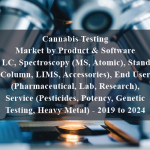OVERVIEW
The Global Mass spectrometry Market is calculated to reach USD 6.5 billion by 2025, growing at a CAGR of 7.21% during the forecast period 2020-2025. The factor such as technological advancements in mass spectrometry, government initiatives for pollution control and environmental testing, and increasing spending on pharmaceutical R&D across the globe are expected to propel the growth of market.








TABLE OF CONTENT
1 Global Mass spectrometry Market
1.1 Study Objectives
1.2 Market Definition
1.3 Study Scope
1.3.1 Markets Covered
1.3.2 Geographic Scope
2 RESEARCH METHODOLOGY
2.1 Research Data
2.1.1 Secondary Data
2.1.1.1 Key Data From Secondary Sources
2.1.2 Primary Data
2.1.2.1 Key Data From Primary Sources
2.1.2.2 Key Industry Insights
2.1.2.3 Breakdown of Primaries
2.2 Market Size Estimation
2.2.1 Bottom-Up Approach
2.2.2 Top-Down Approach
2.3 Market Breakdown and Data Triangulation
2.4 Research Assumptions
3 Global Mass spectrometry Market – Executive Summary
3.1 Market Revenue, Market Size and Key Trends by Company
3.2 Key Trends by type of Application
3.3 Key Trends segmented by Geography
4 Global Mass spectrometry Market – Comparative Analysis
4.1 Product Benchmarking – Top 10 companies
4.2 Top 5 Financials Analysis
4.3 Market Value split by Top 10 companies
4.4 Patent Analysis – Top 10 companies
4.5 Pricing Analysis
5 Global Mass spectrometry Market – Industry Market Entry Scenario
5.1 Regulatory Framework Overview
5.2 New Business and Ease of Doing business index
5.3 Case studies of successful ventures
5.4 Customer Analysis – Top 10 companies
6 Global Mass spectrometry Market – Market Forces
6.1 Introduction
6.2 Market Dynamics
6.2.1 Drivers
6.2.1.1 High prevalence of chronic sinusitis
6.2.1.2 Growing aging population
6.2.1.3 Growing adoption of minimally invasive ENT procedures
6.2.1.4 Increasing presence of prominent players in the Mass spectrometry
Market
6.2.2 Challenges
6.2.2.1 Survival of small players
6.2.2.2 Dearth of skilled otolaryngologists
6.3 Porters Analysis of Market
6.3.1 Bargaining power of suppliers
6.3.2 Bargaining powers of customers
6.3.3 Threat of new entrants
6.3.4 Rivalry among existing players
6.3.5 Threat of substitutes
7 Global Mass spectrometry Market – Strategic Analysis
7.1 Value Chain analysis
7.2 Product Life Cycle
7.3 Supplier and distributor analysis (Market share and product dealing strategies)
8 Global Mass spectrometry Market – By Platform (Market Size – & million/billion)
8.1 Single Mass Spectrometry
8.1.1 Quadrupole
8.1.2 Time-Of-Flight (TOF)
8.1.3 ION Trap
8.2 Hybrid Mass Spectrometry
8.2.1 Fourier Transform Mass Spectrometry (FTMS)
8.2.2 Triple Quadrupole
8.2.3 Quadrupole TOF (Q-TOF)
8.3 Others
9 Global Mass spectrometry Market – By Application
9.1 Pharmaceutical Applications
9.2 Biotech Applications
9.3 Petrochemical Applications
9.4 Environmental Testing
9.5 Food & Beverage Testing
9.6 Other
10 Global Mass spectrometry Market – By Geography (Market Size – & million/billion)
10.1 Introduction
10.2 North America
10.2.1 US
10.2.2 Canada
10.2.3 Mexico
10.3 Europe
10.3.1 U.K
10.3.2 Germany
10.3.3 Italy
10.3.4 France
10.3.5 Spain
10.3.6 Rest of Europe
10.4 Asia-Pacific
10.4.1 China
10.4.2 Japan
10.4.3 India
10.4.4 South Korea
10.4.5 Rest of APAC
10.5 Rest of the World
10.5.1 South America
10.5.2 Middle East
10.5.3 Africa
11 Global Mass spectrometry Market – Entropy
11.1 New product launches
11.2 M&A’s, collaborations, JVs and partnerships
12 Global Mass spectrometry Market Company Profile (Key Players)
12.1 Market Share, Company Revenue, Products, M&A, Developments
12.2 Agilent Technologies
12.3 Sciex
12.4 Waters Corporation
12.5 Bruker
12.6 Thermo Fisher Scientific
12.7 Perkinelmer
12.8 Shimadzu Corporation
12.9 Jeol
12.10 Analytik Jena
12.11 Hiden Analytical
12.12 Company 11 & more
13 Global Mass spectrometry Market – Appendix
13.1 Sources
13.2 Abbreviations












